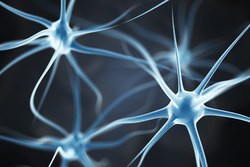Narcolepsy
Narcolepsy is a chronic neurological disorder that affects the region of the central nervous system that regulates sleep and wakefulness. It is characterized by a sudden compulsion to sleep and this compulsion shows up with some regularity. Other names for narcolepsy include hypnolepsy, sleeping disease, paroxysmal sleep, and Gelineau syndrome. The disorder affects an estimated 200,000 Americans and symptoms generally appear in a person’s teens or early twenties.
Narcolepsy is characterized by the following signs and symptoms:
- Sudden, uncontrollable episodes of sleep at inappropriate times, such as while having dinner, talking, driving or working;
- Sudden episodes of loss of muscle tone (This can be precipitated by intense emotion, such as laughter or anger.);
- Inpairment in talking or functioning properly when falling asleep or waking up;
- Vivid, often unpleasant, dream-like experiences while falling asleep;
- Disrupted nighttime sleep with frequent awakenings;
- Performance of routine tasks without memory of the action; and
- Learning and memory difficulties
True narcolepsy affects 0.3 to 0.5% of the population, although there
is growing support for establishment of a “narcrolepsy spectrum” with
the people diagnosed as narcoleptics being at one end. The
neurotransmitter class hypocretins seem bound up in narcolepsy, and
patients have lower-than-normal levels in the brain. Indeed, dogs and
mice without hypocretin receptors have narcolepsy, although that
doesn’t mean this is the mechanism that causes narcolepsy in humans.
However, post-mortem studies of the brains of narcoleptics found a
significant reduction in the number of hypocretin neurons.
Nacroleptics have only about a tenth as many hypcretic neurons as
regular people.
It has been hypothesized that the decreased cell number is due to a mutation in the DNA code for hypocretin but it appears that fewer than 2% of narcoleptics have such a mutation. A degeneration of the nervous system – a death of relevant cells – seems to be the best explanation.
Some experts feel that diagnosis rates are as low as 50% of the total population of patients. The diagnosis may be delayed as much as 10 years after disease onset due to inadequate patient-physician communication and/or misdiagnosis.
The causes of narcolepsy are unknown. Recent findings suggest that the cause may be a damage to some brain cells, in a manner similar to autoimmune diseases.
Download Narcolepsy, a four-page PDF file from the National Heart, Lung, and Blood Institute.
Treatments for narcolepsy include medications that improve alertness and antidepressants to help control cataplexy. Narcolepsy has in the past been treated with amphetamine or amphetamine-like stimulants, most commonly methylphenidate (Riatlin), pemoline (Cylert), methamphetamine (Desoxyn), and dextroamphetamine (Dexedrine). Some patients still take these medicines, but Modafinil has become the standard treatment for narcolepsy. In 2009 the American Academy of Sleep Medicine released guidelines for nacrolepsy treatment that stated "due to clear evidence of efficacy, modafinil is regarded as standard treatment for sleepiness in narcolepsy." Several studies have found Modafnil relieves excessive sleepiness in narcoleptics, but does not relieve cataplexy.
With good toleration by the body and fewer sympathomimetic and side effects, Modafinil is not a domaminiergic, yet still has a lower potency than the amphetamine-like stimulants. Modafinil is approved by FDA for sleepiness associated with narcolepsy.
A typical dosage is 200 mg/day. Some patients (with their doctor's approval) split the dosage to get wakefullness throughout the day.
Excerpts from the Stanford School of Medicine's FAQ on Narcolepy.
Causes of excessive daytime sleepiness
Sodium oxybate is prescribed for cataplexy and disrupted sleep in narcolepsy. Stimulants like amphetamines used to be used for nacrolepsy, and to some extent they still are, but the medical profession now considers the cost-benefit tradeoff of those drugs to not be favorable, especially now that Modafinil is available.
Obstructive sleep apnea/hypopnea syndrome (OSAHS)
OSAHS is a serious, potentially life threatening breathing disorder which affects 6 million adult Americans. Some studies indicate that it is associated with an increased risk of heart attack and stroke. More common in men than women, OSAHS is experienced by sufferers as a lack of airflow throughout the night. This leads to frequent brief arousals. It occurs in 4 percent of middle-aged men and 2 percent of middle-aged women. Over age 65, the prevalence rises to 28 percent and 24 percent for men and women respectively. OSAHS has been the focus of extensive research because of its association with neurocognitive and cardiovascular complications
OSAHS is characterized by the following symptoms:
- Brief interruptions of air flow during sleep and loss of oxygen;
- Repetitive arousals, often unnoticed, during sleep;
- Falling asleep at inappropriate times during the day, such as while driving, working or talking;
- Early morning headaches;
- Depression, irritability and sexual dysfunction; and
- Learning and memory difficulties
Patients with obstructive sleep apnea often have residual daytime sleepiness despite regular use of nasal CPAP therapy. A 2006 guideline on the U.S. government's website states: "Modafinil is recommended for the treatment of residual excessive daytime sleepiness in OSA patients who have sleepiness despite effective positive airway pressure (PAP) treatment and who are lacking any other identifiable cause for their sleepiness." Modafinil should only be used as a supplementary treatment for OSAHS. It should not be used as a substitute for the most common treatment for sleep apnea: continuous positive air pressure (CPAP), a device that keeps air passages open during sleep and prevents the breathing pauses associated with the condition.
Shift work sleep disorder (SWSD)
SWSD is a real sleep disorder - not a whiney complaint some people. Workers who rotate shifts or work at night, such as doctors, police, emergency personnel, and construction and factory workers. SWSD is a recurring pattern of sleep interruption from job demands that results in excessive sleepiness when the person wants to be awake. The body’s natural circadian rhythms make it difficult for those who don’t work the traditional 9 to 5 hours adjust to their schedule. The human body naturally follows a 24-hour period of wakefulness and sleepiness that is regulated by an internal circadian clock that regulates cycles in body temperature, hormones, heart rate and other body functions. For humans, the desire to sleep is strongest between midnight and 6 am. Many people are alert in the morning with a natural dip in alertness in the mid-afternoon. It is very difficult to reset the internal circadian clock to make those who work at night feel sleepy during the day and alert at night. An estimated 10 to 20 percent of night shift workers fall asleep on the job, which not only hinders their work and makes them more prone to accidents, but makes it difficult for them to sleep during the day, even though they are tired.
 SWSD is primarily experienced by people working at night or individuals
on schedules that require them to work and sleep at irregular times. For
instance, a health care worker on a schedule such as 8 am to 4 pm Monday
and Tuesday and 12 to 8 am Thursday and Friday would be prone to SWSD.
More on SWSD
SWSD is primarily experienced by people working at night or individuals
on schedules that require them to work and sleep at irregular times. For
instance, a health care worker on a schedule such as 8 am to 4 pm Monday
and Tuesday and 12 to 8 am Thursday and Friday would be prone to SWSD.
More on SWSD
Is Modafinil ever prescribed for conditions other than the ones the drug is FDA-approved for?
Modafinil is sometime prescribed to people for "off-label" or “lifestyle” uses, including:
- Age-related memory decline
- Attention deficit disorder
- Depression
- Fatigue caused by high-pressure jobs requiring long hours
- Fatigue caused by chemotherapy treatment for cancer patients
- Fatigue experienced by persons suffering from diseases such as multiple sclerosis
- Fatigue experienced by people who need to be awake and alert for extended amounts of times such as soldiers, truckers or students cramming for finals
- Jet lag
- Memory problems associated with Alzheimer’s disease
- Post-anesthesia grogginess
- Sleepiness caused by other prescription medications
- Treatment for cocaine addiction
See also: Which clinical conditions are responsible for impaired alertness?
(Does Modafinil improve memory?)
Different Kind of Stimulant
